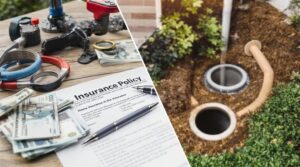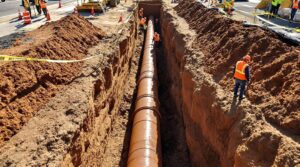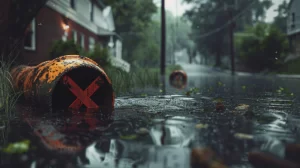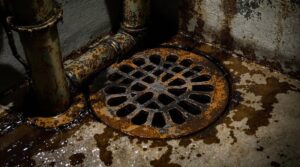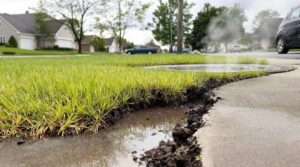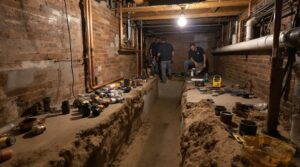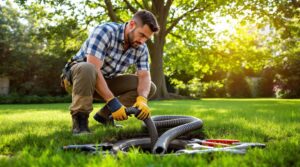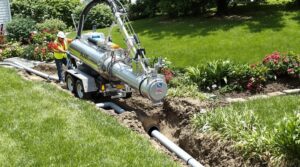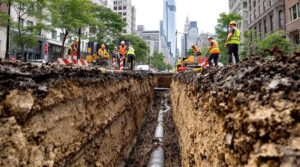Sewer line replacement typically requires 1-3 days for standard residential projects, though complex installations can extend to 5 days or more. The timeline varies based on important factors including excavation depth, pipe length, site accessibility, and local regulations. Urban properties often demand additional time due to utility congestion and complex underground networks. Weather conditions, permit requirements, and unforeseen obstacles can further impact completion schedules. Understanding these variables helps property owners prepare for best project management.
Key Takeaways
- Standard residential sewer line replacements typically take 1-3 days for completion under normal conditions.
- Complex urban installations may require up to 5 days due to utility congestion and accessibility challenges.
- Depth significantly impacts duration, with excavations over 8 feet requiring additional time and specialized equipment.
- Minor repairs can be completed in 1-3 hours, while trenchless technologies can reduce replacement time to two days.
- Weather conditions, permit delays, and underground obstacles can extend project timelines beyond standard estimates.
Understanding Sewer Line Replacement Basics
Sewer line replacement represents a complex infrastructure project that requires careful planning, professional expertise, and systematic execution.
The process begins with a thorough assessment using video camera inspection to evaluate the condition of existing pipes and determine the most appropriate replacement methods. This initial phase helps identify the severity of damage and guides the selection of suitable sewer line materials. Specialists utilize specialized equipment to perform comprehensive diagnostics of the entire system.
Professional contractors must obtain necessary permits and develop detailed plans before commencing work. The replacement can be performed using either traditional excavation methods or modern trenchless technologies.
Traditional approaches involve digging trenches to access and replace the pipe, while trenchless methods like pipe bursting or pull-in-place lining minimize surface disruption. The choice between these methods depends on factors such as pipe location, site conditions, and local regulations.
Throughout the process, temporary sewer service may need to be maintained to accommodate building occupants while ensuring compliance with municipal codes.
Key Factors That Affect Replacement Duration
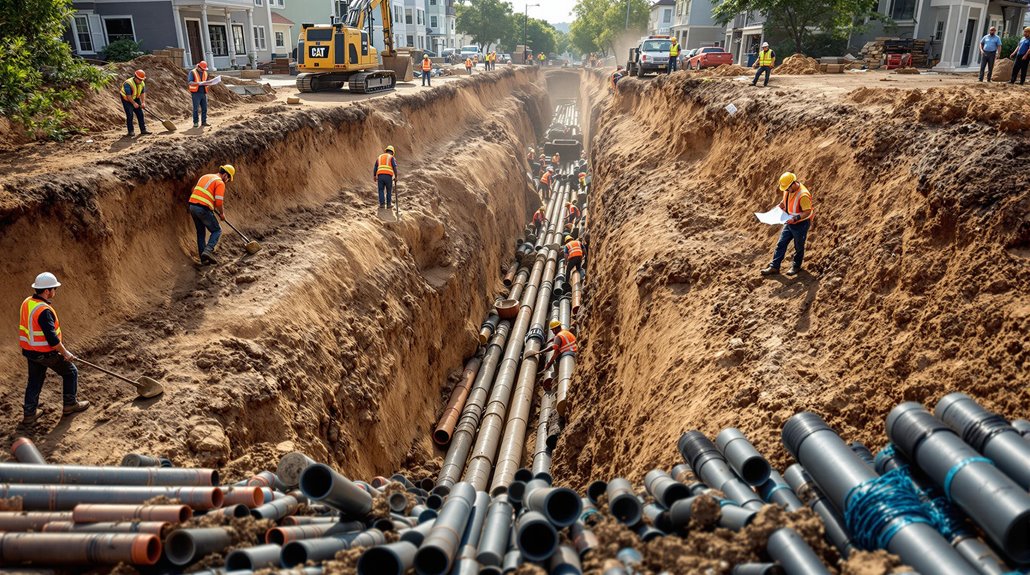
The duration of sewer line replacement projects depends primarily on three critical variables: excavation depth, site accessibility, and total pipe length requirements.
Deeper excavations, particularly those exceeding 8 feet or involving basement-level connections, typically extend project timelines by several days compared to shallow, slab-on-grade installations. A typical replacement takes 1 to 5 days depending on these conditions.
Site conditions such as urban utility congestion, terrain challenges, and the distance between connection points directly influence both the complexity and timeline of the replacement process.
Depth and Terrain Impact
Digging deep into the earth presents one of the most significant challenges when replacing sewer lines, with excavation depth directly impacting project duration and complexity. Professional excavation techniques require careful soil assessments to determine appropriate methods and equipment deployment. Projects exceeding eight feet in depth typically demand additional resources and specialized machinery. Neighboring properties may need to be consulted when deep excavation work is required near shared property lines.
| Depth Factor | Impact on Project |
|---|---|
| < 5 feet | Standard timeline, minimal complications |
| 5-8 feet | Moderate complexity, additional safety measures |
| 8-12 feet | Extended timeline, heavy machinery required |
| > 12 feet | Complex planning, significant resource allocation |
The presence of utility lines, tree roots, and underground obstacles further complicates deep excavations, necessitating precise planning and execution. Soil composition plays a vital role, with rocky or clay-heavy terrain requiring more extensive excavation efforts compared to sandy soils.
Access to Work Site
When evaluating sewer line replacement timelines, access to the work site emerges as a vital determinant that greatly influences project duration and complexity. Site accessibility challenges and regulatory requirements can notably impact project management efficiency and overall completion time.
Key factors affecting duration include:
- Underground obstacles: Utility lines, paved surfaces, and landscaping features require careful navigation and specialized excavation techniques.
- Regulatory compliance: Permit acquisition, local guidelines, and notification requirements must be addressed before work commences.
- Location constraints: Metropolitan areas with high utility density, restricted access zones, and neighboring property considerations demand additional planning.
The presence of these factors often necessitates specialized equipment and expertise, while material availability and labor requirements further influence the project timeline.
Efficient project management becomes essential in coordinating these various elements to minimize delays.
Pipe Length Considerations
Since pipe length directly correlates with project duration, understanding the specific length requirements becomes essential for accurate timeline estimation in sewer line replacements. Longer pipe runs inherently demand more extensive excavation, with significant variations between 20-foot and 100-foot installations typically resulting in project durations ranging from one to five days.
Property configuration presents additional pipe run challenges, particularly in urban environments where congested utility infrastructure can complicate installation processes.
Extensive front yards and larger properties often necessitate longer pipe runs, requiring more thorough planning and execution time. These landscaping impacts become especially pronounced when maneuvering through developed areas, where longer runs may intersect with existing utilities or require additional coordination with neighboring properties.
The complexity increases proportionally with the length of the replacement section.
Typical Timeframes for Different Property Types
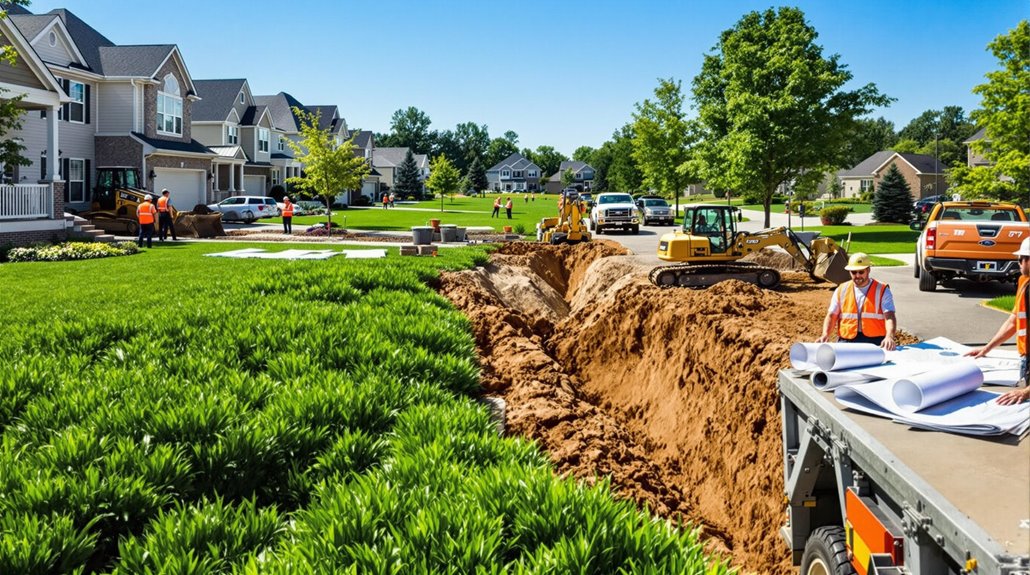
Sewer line replacement durations vary greatly across different property types, with residential projects typically requiring 1-3 days for completion under standard conditions.
Urban properties face additional complexities due to dense utility networks and strict municipal regulations, often extending timelines to 5 days or more in challenging cases.
Rural properties, while generally following the standard 1-3 day timeline, can experience unique challenges related to extended line lengths, difficult terrain access, and limited availability of specialized equipment or materials.
Residential Home Timeline Basics
Understanding the timeline for a sewer line replacement is essential for homeowners to properly plan and prepare for the project.
The duration varies based on multiple factors, including the length of pipe, soil conditions, and chosen replacement methods. While traditional trenching typically requires three or more days, trenchless technologies can complete the job in two days or less.
Key timeline expectations for residential sewer line projects:
- Minor repairs and clog removal: 1-3 hours
- Standard residential replacements: 1-3 days
- Complex installations with back-pitched lines: up to 5 days
Local regulations, weather conditions, and unforeseen complications can affect these timeframes.
Proper planning allows homeowners to make necessary arrangements for alternative accommodations and minimize disruptions during the replacement process.
Urban Property Complex Factors
Urban properties present distinct challenges that greatly influence sewer line replacement timeframes. In urban infrastructure settings, factors such as deep pipe placement and utility line interference can extend project duration markedly. Excavations beyond eight feet typically require specialized equipment and additional time for completion.
Sewer maintenance in urban environments faces unique accessibility obstacles, including paved surfaces, established landscaping, and neighboring property considerations. These challenges often necessitate careful planning and specialized approaches.
The complexity increases further due to stringent regulatory requirements, with multiple agencies overseeing permitting processes. Environmental factors like weather conditions and existing pipe damage also impact timelines.
Professional contractors must navigate these urban complexities while managing traffic control measures and coordinating with various stakeholders to guarantee efficient project completion.
Rural Property Considerations
In rural settings, sewer line replacement typically requires one to three days for completion, with variations depending on property characteristics and installation methods.
Rural infrastructure presents unique challenges that can affect project duration, particularly when specialized excavation equipment is required for difficult terrain or extended pipe runs.
Key factors affecting rural replacement timelines include:
- Property accessibility and distance from main connections
- Depth of existing lines and soil composition
- Presence of unmapped underground utilities or obstacles
Trenchless technologies can expedite the process in suitable conditions, often reducing completion time to two days or less.
However, rural properties frequently require traditional excavation methods due to longer pipe runs and complex terrain features.
Weather conditions and the need for specialized equipment can further impact project timeline estimates.
Common Challenges and Delays
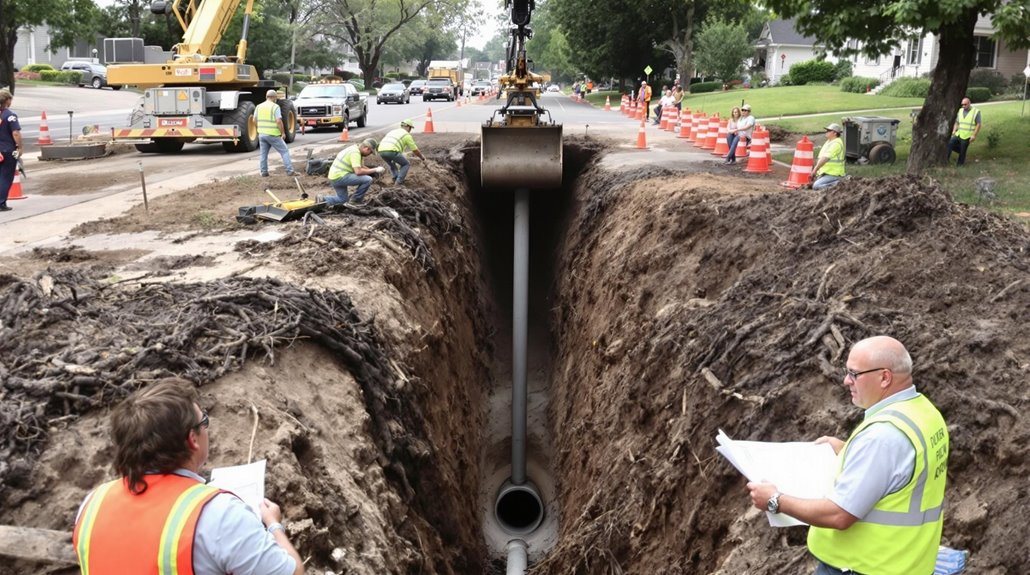
Several notable challenges can impede the timely completion of sewer line replacement projects. Weather conditions pose substantial excavation challenges, with excessive rainfall causing water accumulation at dig sites and frozen ground during cold seasons complicating the excavation process. Thunderstorms and extreme weather events can force work stoppages to guarantee crew safety and compliance with regulations.
The complexity of the replacement process varies based on accessibility factors and pipe conditions. Sewer lines located beneath structures or those requiring extensive repairs typically demand longer completion times.
The age and material of existing pipes, coupled with the chosen replacement method, directly influence the project duration. Additionally, delays in obtaining permits and compliance with local regulations can extend timelines markedly.
These impediments can result in serious consequences, including sewage backups, environmental contamination, and increased repair costs if not addressed promptly.
Modern Vs Traditional Replacement Methods
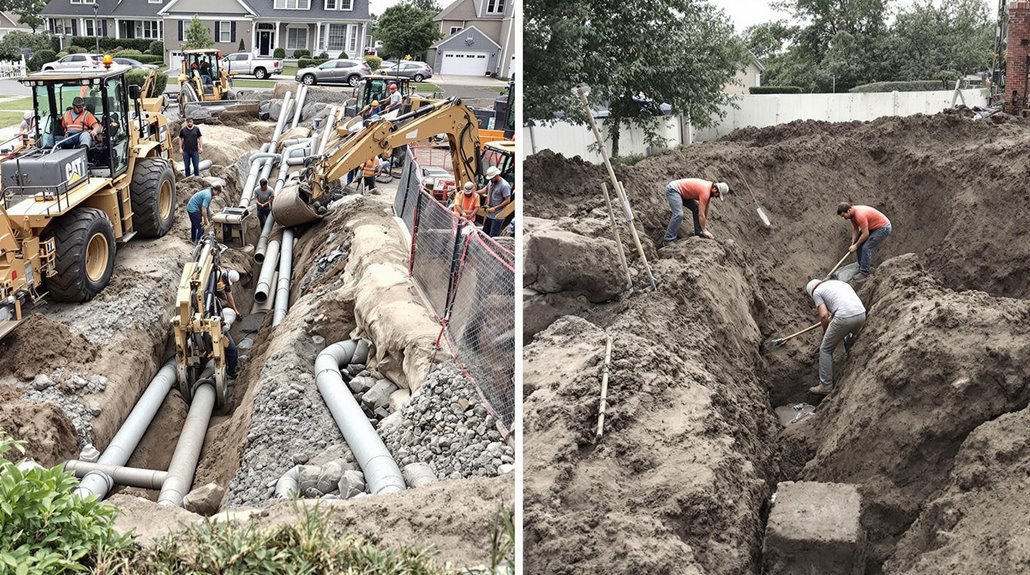
Modern sewer line replacement approaches offer significant advantages over conventional excavation methods, fundamentally altering the landscape of plumbing repairs.
Traditional excavation involves extensive digging, property disruption, and lengthy restoration periods, while trenchless technology benefits include minimal surface disturbance and faster completion times.
Key distinctions between these methods include:
- Time Efficiency: Traditional replacements typically require several days to weeks, whereas trenchless methods can be completed in 1-2 days.
- Property Impact: Conventional excavation necessitates extensive digging and landscape restoration, while trenchless approaches require only small access points.
- Cost Structure: Traditional methods incur higher labor, equipment, and restoration costs, though trenchless solutions often provide long-term cost benefits.
Excavation challenges such as property damage and extended project timelines have driven innovations in trenchless technologies.
Methods like pipe bursting, horizontal directional drilling, and cured-in-place pipe lining now offer efficient alternatives that maintain structural integrity while minimizing disruption to residential and commercial properties.
Professional Assessment and Planning
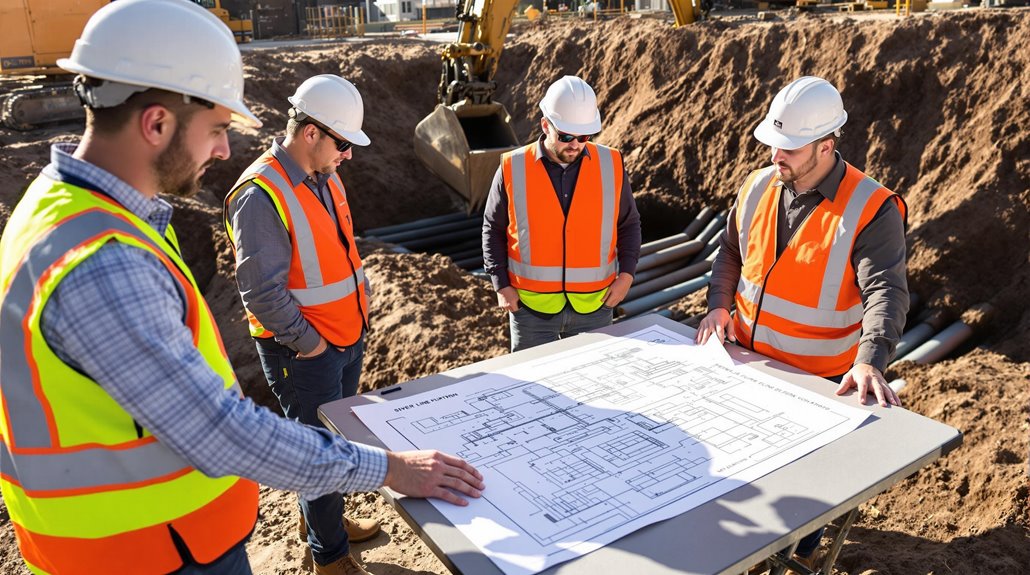
Professional assessment and planning serve as critical foundations for successful sewer line replacements, requiring thorough evaluation through specialized diagnostic tools and methodical analysis. The project coordination begins with a detailed inspection process utilizing advanced technologies like sewer cameras to determine the extent of damage and necessary interventions.
| Assessment Phase | Key Components |
|---|---|
| Initial Inspection | Visual examination, surface damage evaluation |
| Technical Analysis | Camera inspection, diagnostic testing |
| Damage Assessment | Severity classification, repair scope |
| Solution Planning | Method selection, timeline development |
During the professional evaluation, contractors analyze multiple factors affecting replacement duration, including line accessibility, damage severity, and local regulations. This systematic approach enables specialists to develop precise timelines, estimate costs accurately, and guarantee compliance with building codes. The assessment phase also addresses potential health risks and safety concerns, allowing homeowners to make informed decisions about temporary accommodations during the replacement process.
Cost Implications of Project Duration
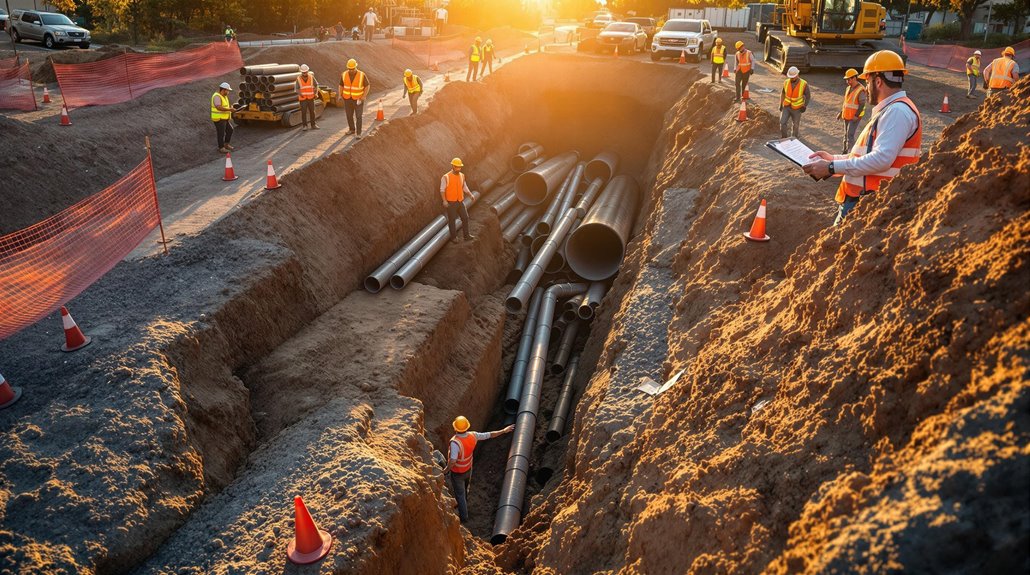
The relationship between project duration and total cost forms a critical consideration in sewer line replacements, encompassing both direct expenses and auxiliary financial impacts.
Budget estimation must account for multiple variables that escalate with extended timelines, including equipment rentals, labor hours, and potential complications. Contractor selection greatly influences both project duration and associated costs, as experienced professionals may command higher rates but often complete work more efficiently.
Key cost factors affected by longer project durations include:
- Material expenses increase due to extended equipment rentals and potential additional supplies needed for unforeseen repairs.
- Labor costs escalate through overtime hours, specialized workforce requirements, and extended project timelines.
- Overhead costs expand with prolonged permit requirements, safety measures, and temporary service provisions.
Understanding these time-dependent cost implications enables property owners to better prepare for financial obligations while maintaining realistic expectations about project scope and duration.
Essential Preparations Before Replacement
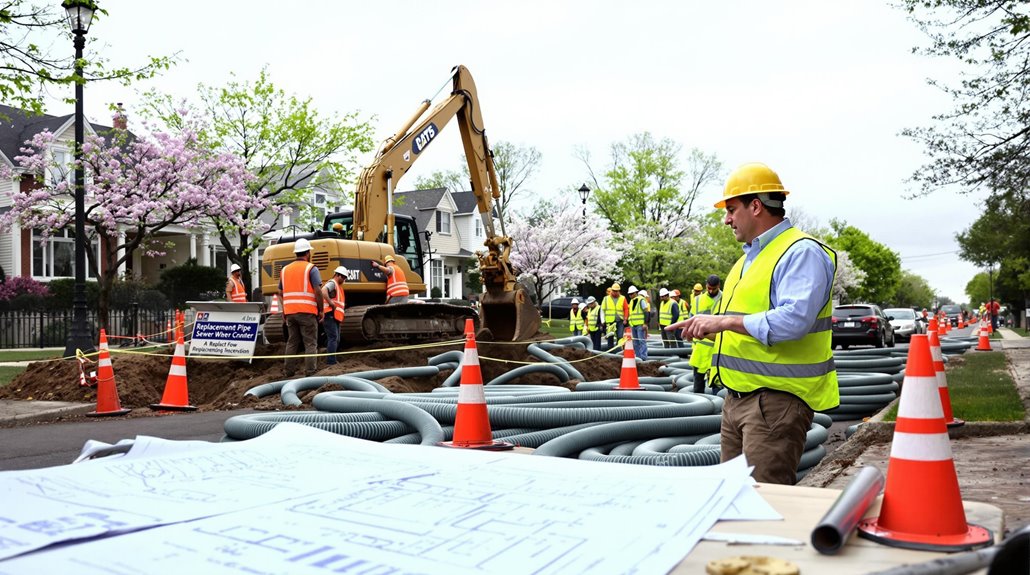
While managing costs remains a key consideration, thorough preparation before sewer line replacement noticeably impacts project success and efficiency.
Property owners must prioritize excavation safety by removing all obstacles from the work site, including outdoor furniture, toys, and vehicles that could impede access to the sewer line.
Utility marking stands as a critical safety measure, requiring professional identification and marking of underground gas, water, and electrical lines before any digging commences.
Additionally, homeowners should establish alternative arrangements for water usage during the project period, which typically spans one to three days. This may include securing portable toilets or temporary relocation arrangements.
Communication with neighbors about the upcoming work schedule and obtaining necessary permits through the contractor safeguards regulatory compliance.
The contractor must verify local codes and schedule required inspections to maintain project legitimacy and safety standards throughout the replacement process.
Tips for Minimizing Project Timeline
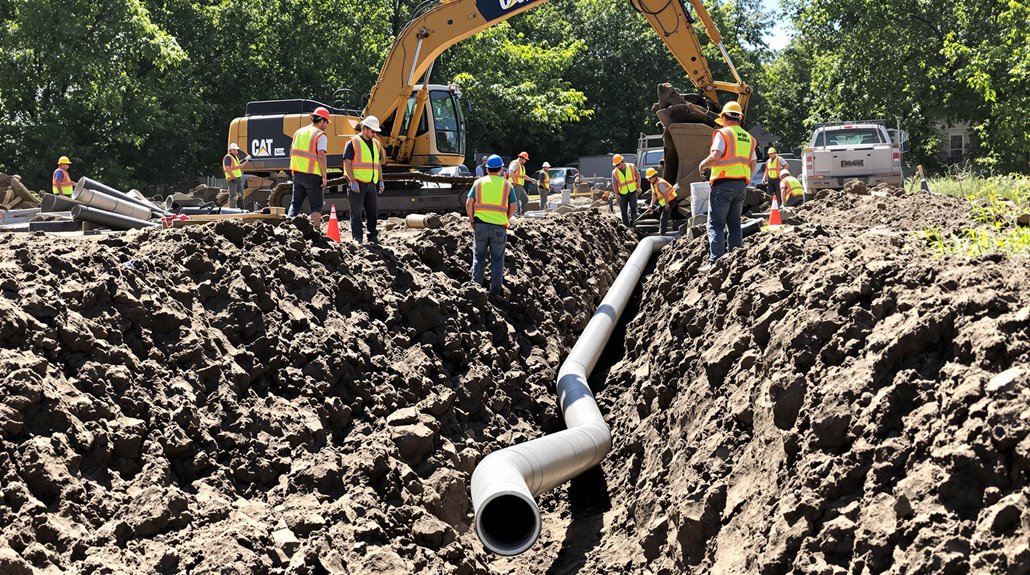
Successfully minimizing the timeline of a sewer line replacement project depends heavily on strategic planning and efficient execution methods. Following best practices in project scheduling and implementation can notably reduce completion time while maintaining quality standards.
Key strategies for optimizing the replacement timeline include:
- Selecting trenchless repair methods when feasible, as these techniques typically require less time than traditional excavation.
- Confirming all necessary materials and equipment are secured before project initiation to prevent delays.
- Obtaining permits and regulatory approvals early in the planning phase.
Advanced preparation through thorough assessments and diagnostics helps identify potential challenges before work begins.
Experienced contractors can execute precise timelines by utilizing modern equipment and efficient replacement techniques. Weather considerations should be factored into project scheduling, with contingency plans established for potential delays.
Maintaining clear communication channels between contractors and property owners ensures smooth progression through each phase of the replacement process.
The Benefits Of Consulting A Public Adjuster
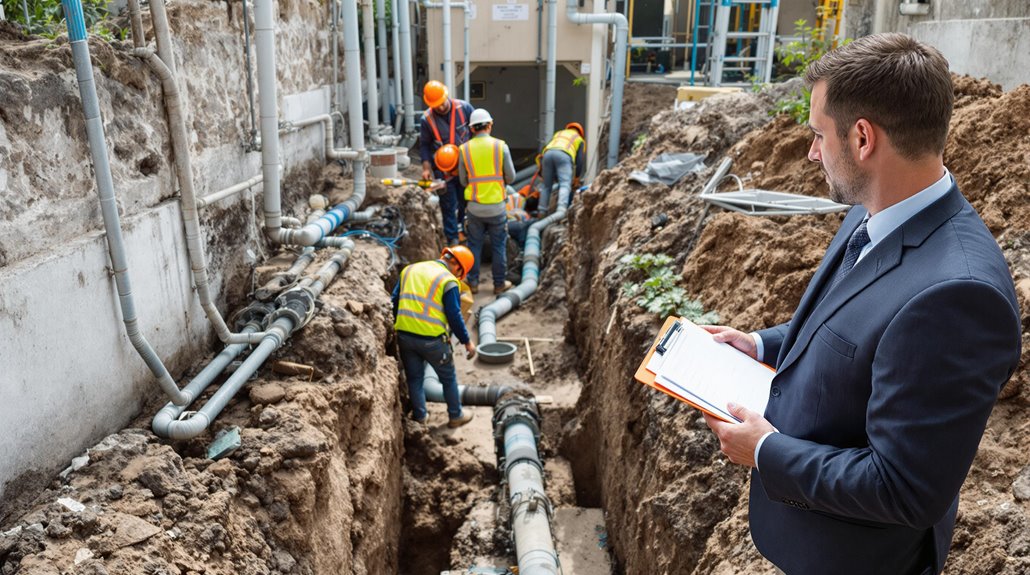
When dealing with sewer line replacement claims, consulting a public adjuster provides expert guidance through complex insurance processes and objective damage assessments.
Public adjusters streamline the claims process by managing documentation, negotiations, and communications with insurance companies on behalf of property owners.
Their specialized knowledge and experience often result in considerably higher claim settlements compared to self-negotiated outcomes, making their services particularly valuable for extensive projects like sewer line replacements.
Studies show that claims handled by licensed public adjusters can result in settlements up to 500% higher than those negotiated without professional representation.
Expertise In Insurance Claims
For complex sewer line insurance claims, consulting a public adjuster can considerably improve the likelihood of a fair settlement.
These licensed professionals possess extensive claim strategy expertise and policy insights that enable thorough evaluation of coverage options and potential compensation.
Public adjusters provide critical advantages through their systematic approach:
- Detailed policy review to identify applicable coverages and maximize settlement potential.
- Detailed documentation and inspection of sewer line damage to support claim negotiations.
- Expert negotiation with insurance carriers to secure best compensation while minimizing out-of-pocket expenses.
Their professional representation removes emotional stress from the claims process while ensuring compliance with state regulations.
Working on a contingency basis, public adjusters align their interests with the policyholder's goal of achieving the most favorable settlement possible.
Unlike insurance adjusters who represent carriers, public adjuster fees are typically capped at 10% of the total claim settlement to ensure fair practices.
Objective Damage Assessment
Professional damage assessment through a public adjuster provides critical objectivity in evaluating sewer line conditions and replacement needs.
Through systematic analysis of pipeline materials and thorough inspection techniques, adjusters determine the precise extent of damage, accessibility challenges, and ideal replacement methods.
This objective evaluation considers multiple factors, including the location of damage, depth requirements, and existing pipeline materials. The assessment process examines whether traditional trenching or trenchless methods would be most efficient, with timelines typically ranging from 1-3 days for standard replacements to 4-5 days for complex situations.
Such detailed analysis helps property owners understand projected timelines, anticipate potential complications, and plan accordingly.
Additionally, proper assessment guarantees compliance with local regulations while identifying the most cost-effective and time-efficient repair solutions.
Working with a public adjuster who charges contingency-based fees of 5-20% ensures property owners receive fair compensation for sewer line damages without paying upfront costs.
Streamlined Claim Process
Consulting a public adjuster considerably streamlines the sewer line replacement claims process through expert advocacy and systematic management.
Their professional expertise guarantees efficient documentation and accurate representation of policyholder interests while maintaining streamlined communication with insurance carriers.
Public adjusters enhance the claims process through:
- Implementation of advanced claims management systems that automate documentation and expedite settlements
- Professional handling of complex paperwork and negotiations, reducing administrative burden on property owners
- Utilization of data analytics and real-time collaboration tools to ascertain accurate damage assessment and fair compensation
This systematic approach not only accelerates claim resolution but also minimizes the risk of claim denials through thorough compliance with policy requirements.
Property owners benefit from reduced stress and faster access to necessary funds for sewer line replacement.
With settlement rates typically ranging from 5% to 15%, public adjusters deliver value through their ability to secure higher compensation for property damage claims.
Higher Claim Payouts & Settlements
One of the primary advantages of engaging a public adjuster lies in their ability to secure higher claim payouts and settlements for sewer line replacements. These professionals employ expert claim negotiation techniques, leveraging their thorough understanding of insurance policies and industry practices to maximize settlement amounts.
Public adjuster benefits extend beyond basic negotiation. They conduct extensive damage assessments, documenting all aspects of sewer line damage that might otherwise be overlooked.
Their objective evaluations and detailed documentation strengthen the claim's position. Working on a contingency basis, typically charging up to 10% of the settlement, public adjusters are motivated to achieve optimal results.
Their expertise in identifying damages, combined with their knowledge of insurance company tactics, enables them to advocate effectively for policyholders and secure more favorable settlement outcomes. Effective communication between adjusters, contractors, and homeowners significantly enhances the likelihood of successful claims and higher settlements.
About The Public Claims Adjusters Network (PCAN)
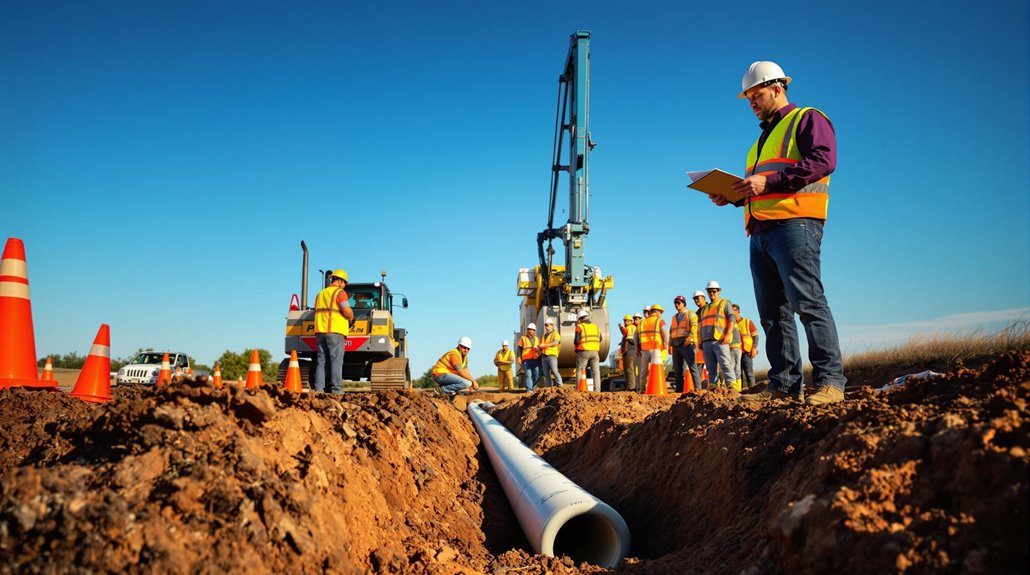
The Public Claims Adjusters Network (PCAN) represents a collective of licensed insurance claims professionals who advocate exclusively for property owners during the claims settlement process.
These public adjusters leverage their extensive expertise in insurance advocacy and claim negotiation to maximize settlements for their clients. The network benefits property owners through thorough claim management, detailed damage assessments, and professional representation throughout the entire claims process.
Key advantages of working with PCAN include:
- Professional adjusters work on a contingency basis, requiring no upfront fees
- Extensive documentation and support services throughout the claims process
- Higher settlement rates through expert negotiation strategies
PCAN members maintain proper licensing and bonding requirements while adhering to strict professional standards.
Their expertise in local regulations and insurance procedures enables them to navigate complex claims effectively, ensuring property owners receive fair compensation for their losses.
Frequently Asked Questions
Can I Use My Plumbing During a Sewer Line Replacement?
Plumbing restrictions typically prevent water usage during sewer line replacement. Contractors may provide temporary solutions like portable facilities or alternative connections to maintain essential household functions during construction.
Will My Yard Need to Be Completely Dug Up?
Modern digging techniques minimize yard disruption. Complete excavation is rarely necessary, especially with trenchless methods. However, some areas will require digging followed by professional yard restoration.
How Soon After Replacement Can Landscaping Be Restored?
After the ground settles from its slumber, landscaping restoration typically requires a minimum two-month waiting period. The complete restoration process may extend through ideal seasonal planting windows for best results.
Are Temporary Bathroom Facilities Provided During the Replacement Process?
Temporary toilets are typically provided during sewer line replacement projects. Professional contractors arrange portable sanitation facilities to maintain sewage management capability throughout the repair duration, ensuring minimal residential disruption.
Will Replacing My Sewer Line Affect My Neighbor's Property?
Studies show 40% of sewer line replacements impact adjacent properties. Excavation work frequently crosses property boundaries, requiring careful neighbor relations management and adherence to established boundary regulations and easements.
References
- https://www.balkanplumbing.com/repair-sewer-line-timeframe-factors/
- https://www.harriswatermainandsewers.com/factors-that-affect-how-long-a-sewer-line-replacement-takes/
- https://barneysplumbingllc.com/blog/replacing-sewer-line-from-house-to-main-how-long-will-this-take/
- https://callhonest.com/how-long-does-it-take-replace-sewer-line
- https://www.mb-servicesllc.com/2024/02/29/sewer-line-replacement/
- https://nextlevelpipelining.com/the-sewer-line-replacement-process-what-homeowners-can-expect/
- https://skeenplumbinggas.com/blog/understanding-the-sewer-replacement-process-a-simplified-guide/
- https://www.cartersmyplumber.com/how-long-replace-sewer-line/
- https://www.delvalseptics.com/how-long-does-it-take-to-replace-sewer-line/
- https://www.kimley-horn.com/news-insights/perspectives/pipe-bursting-quick-easy-solution-sewer-line-replacement/
